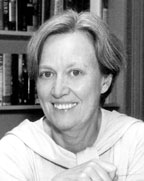
Shirley M. Tilghman |
Engineering for a Better World: A Vision for Princeton
For the last eight months the School of Engineering and Applied Science (SEAS) has been in high gear as it debates and plans its future. This year was an ideal time for such a discussion, coming shortly after the arrival of Dean Maria Klawe in January 2002. She was eager to build on the past successes of Dean Jim Wei, but in a way that reflected the significant changes that the profession of engineering is undergoing. For one thing, the pace of discovery in many fields of engineering and applied science has been increasing rapidly over the last decade, bringing with it great advances such as wireless Internet connections and better materials to repair heart valves. With those advances have come challenges to our social order as well. For example, our increased dependence on information technology at work and at home has heightened the need to prevent information from getting into the wrong hands. New fields of engineering that cut across the classical disciplinary boundaries of most engineering schools, such as bioengineering and nanotechnology, are being born. The time was ripe for Princeton to consider how our distinctive engineering school, situated within one of the world’s finest liberal arts research universities, could help to lead the technology revolution through both its research and the education of leaders.
Toward that end Dean Klawe led an exhaustive planning process that included engineering faculty, students, staff, and alumni, as well as faculty from other departments and universities and even the deans of several other engineering schools. Over the course of eight months, in 11 workshops, interviews, meetings, and Web-based outreach, they developed a strategic plan to ensure that Princeton plays a distinctive leadership role in engineering education and research. Dean Klawe has been engaging alumni in discussions of this evolving plan through travels to Boston, Seattle, San Jose and Washington, D.C., and she will be presenting a new vision for the school at Reunions on Friday, May 28. I encourage all who are interested to attend; for those who cannot, the final report is available on the SEAS website (www.princeton.edu/~seasplan/).
The plan capitalizes on strengths that already exist at Princeton. Our relatively small size encourages a high level of collaboration across departments—both within and outside the school. Some collaborations are to be expected, such as those between our engineers and physicists, but others are not, such as the creative collaboration between Professor of Computer Science Perry Cook and Professor of Music Paul Lansky. The development of interdisciplinary groups within SEAS also has flourished in recent years, with the creation of the Princeton Institute for Science and Technology of Materials (PRISM) to explores the interface between soft and hard materials. With excellence in the social sciences and the Woodrow Wilson School, Princeton is well positioned to think about the impact of technological change on society. Finally, we have a well-earned reputation for educating our engineering students broadly, so that they are superbly trained in the technical aspects of engineering, able to communicate clearly to a wide audience, and to grow into leadership roles in industry, government, and academia. These themes make up the core of the strategic plan for Princeton: to set a new standard for excellence in engineering education and research by emphasizing an interdisciplinary perspective and a greater understanding of the impact of technology on society.
While maintaining rigor and depth in the core engineering disciplines, the school is developing a curriculum that will make much greater use of integrative approaches across multiple disciplines (in and out of engineering) and a much more deliberate effort to teach engineering methods and theories through application to realworld problems. Among the recommended steps is developing a new first-year undergraduate curriculum that provides the opportunity for students to learn mathematics and physics in the context of engineering applications. It is expected that this problemoriented approach will have broad appeal to students, and stem the tide of students who leave the study of engineering after their freshman year. Through new summer internships, greater incorporation of outside experts as visiting faculty, and greater support of student entrepreneurial activities, the school will expand its students’ real world experience. It will encourage its engineering students to develop an appreciation of the historical, political, economic, and social context within which engineering challenges must be addressed. With an expanded curriculum, the school also intends to reach out to a broad population of students, including nonengineers, minorities, and women, whose views have been underrepresented in engineering yet are critical to understanding and solving societal problems.
No engineering school can be preeminent without a strong commitment to excellence in research. The strategic plan identifies important research areas where Princeton already has built critical mass, such as materials science, information technology, and the study of complex systems. In addition, the planners have identified areas where we might develop new expertise, such as research that seeks to improve the lives of people in disadvantaged and developing regions of the world, by designing projects in sustainable energy, creating new building materials, and using information technology to foster small industry. Such research efforts will require collaborations with the Woodrow Wilson School, the Princeton Environmental Institute, the Princeton Institute for International and Regional Studies, and departments in the life and natural sciences.
To my mind this is an exciting vision for Princeton engineering. Dean
Klawe and her colleagues have clearly stated their intention to make the
school one of the best in the nation—but, equally important, one
that has the distinctive Princeton character of marrying world-class scholarship
with a dedication to innovative teaching. As she says in the strategic
planning report, “We recognize that we have set ambitious goals,
but are convinced that we have both the responsibility and opportunity
to achieve them. Our vision builds on what is best about Princeton: an
uncompromising pursuit of academic excellence; a broad, humanistic view
of education, and a tradition of leadership and service.”![]()

